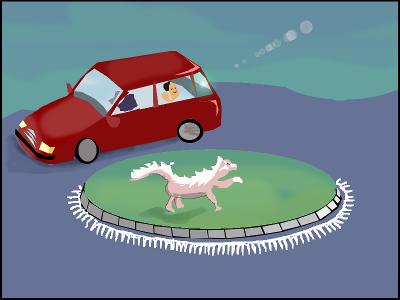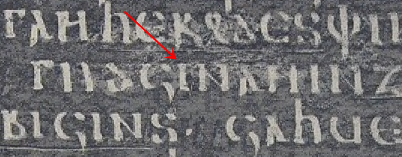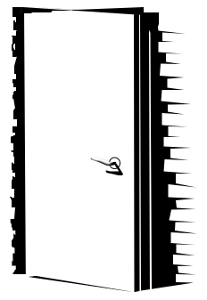1. Tyre
2. Dan
3. The Copper Snake
Category Archives: Language
What connects prophets with roundabout dogs?
Maybe you aren’t fully acquainted with the phenomenon of roundabout dogs. It is a statue of a dog, which somebody places in a roundabout, usually without applying for permission. It has been particularly common in Sweden, though it looks like it is mostly Scanians and x:th generation immigrants who do this, perhaps to make Swedish society feel less cold.

Typical roundabout dog
Continue reading
Gudja or Gudji
In Luke 1:5 Wulfila.be’s text reads “… gudja namin Zakarias …”. Doesn’t it look like it should be “… gudji namin Zakarias …”, however? (They do note that the text is ‘partially normalized’.)

Benzelius also transcribes “gudji”. In other places this /i/ occurs in the words gudjinon ‘serve as priest’ a few verses later in Luke, and gudjinassus ‘priestly office’ at Luke 1:9 and 2 Corinthians 9:12. So this might be another split word which I couldn’t find by searching digitized texts. On the other hand, the difference between gudja and gudji is so slight that a scribe might well use the form he or she is used to.
In A Comparative Germanic Grammar Eduard Prokosch (or perhaps his editor Bolling) sums up the underlying grammar nicely:
81§
In Germanic all ā-stems are feminines, but elsewhere also masculines occur, denoting types of human beings, e.g., L. scrība, poeta, agricola, OSl. sluga ‘servant’, vojevoda ‘army leader’, Gk. νεανίας ‘youth’.
[…]
B. jā-Stems.
[…]
In Germanic, we find the endings -jā and -ī. Gothic and Old Norse use the former with short stems, the latter with long stems: Go. banja ‘wound’, sibja ‘relationship’, halja ‘hell’, but bandi ‘band’, þiudan-gardi ‘kingdom’, þūsundi ‘thousand’ […]
Balg suggests the word formation as: “from stem of guþs and suff. -jan”. He gives the gender as masculine. Are there any more Gothic masculine words ending in -a? Yesh!
aba ‘husband’ (Irregular in the plural, according to Lambdin 6.1 (p20))
abba ‘father’
afdrugkja ‘drunkard’
aha ‘mind’
ahma ‘spirit’
aiwaggelista ‘evangelist’ (Balg: from L. evangelista)
aldoma ‘old age’ (Only occurring in Luke chapter 1)
allawaurstwa ‘one who works with all his might, perfect’ (Only occurring in Colossians 4:12)
ara ‘eagle’ (Only occurring in Luke 17:37)
atta ‘father’
bandja ‘one being bound’
… and so on.
Lambdin notes for weak nouns that -n remains in all cases and numbers except nominative, so they would have, originally, had stems ending in -n.
I’d point out that aba, abba and atta might be onomatopoetic, originally used by a small child not knowing about cases, and that the case endings for weak nouns contain sequences with prepositional character, namely -in and -an, with the sense of ‘in’ and ‘against/on’, thus expressing the functions of the dative and accusative cases respectively.
Nom: atta
Dat: attin
Acc: attan
Well, well.
In Luke 15:25, the prodigal son’s brother “qimands atiddja neƕ razn”. Me thinks a continental Goth would say and write “qimands atiddja neƕa razn”. What do you think?
How to write Wulfilan script in LaTeX
The Gothic script used in codices Argenteus and Ambrosianus is encoded with more than 24 bits in Unicode/UTF-8. We say they are in the “Second half-pane”. Almost everything else of merit gets encoded with less than 24 bits, so software makers sometimes implements UTF-8 only up to 24 bits and hope that language minorities, who want to use characters above the limit, will be imprisoned for hate speech before reaching their office.
For LaTeX, I have tested only with XeTeX and TextEdit on Mac. We will use the fontspec library. We will also need a Wulfilan typeface as *.otf or *.ttf. We can place a copy in the catalogue where we have the .tex-file.
Continue reading
List of common expressions that differ between Scanian and Sweonic
S = axato (reliable indicator of which dialect)
H = historic difference – the dominating form set in red.
E = blog author was taught in school that the stricken form is “grammatically” wrong.
|
||||||||||||||||||||||||||||||||||||||||||||||||||||||||||||||||||||||||||||||||||||||||||||||||||||||||||||||||||||
Scanian expressions have been normalized to Swedish orthography.
Gothic synonyms: Sunno and sauil
Where the Greek text typically has ἥλιος, Gothic has:
1. sunno (f) ‘sun’ – Matthew 5:45; Luke 4:40; Ephesians 4:26; Nehemiah 7:3.
2. sunno (n) ‘sunshine weather’ – Mark 4:6; 16:2.
3. sauil (n) ‘sun’ – Mark 1:32; 13:24.

Sunno has connections with Old English sunne and OHG sunna, according to Balg’s dictionary. Sauil has similar forms in Old English, Old Norse and Latin sol. It is difficult to say from etymology which form is more likely original and which would be later, however since sunno appears rather often, 6 times versus 2 for sauil, if one form is later it is probably the rarer one.
Was Wulfila’s Exemplar of Luke’s Gospel Marcionite?
We have seen in two previous articles that sometimes the Gothic bible uses one synonym consistently for a number of verses and then switches to using another synonym for a few verses. How about studying synonyms and orthographic variants to see if we can isolate an older textform? I do, and even though I am only halfway through, I dare say it correlates with the text reconstructed for Marcion’s gospel of Luke, to a certain extent.
How can that be?
Words for 'white'
The Hebrew word for white is laban — לבן. A figure with this name occurs in Genesis chapter 29 and onwards.
When Jacob was sent to Haran in search of a wife, it was not because a white one would be better, as we can see in chapter 28:
Now Esau saw that Isaac had blessed Jacob and sent him away to Paddan-aram to take a wife from there, and that as he blessed him he directed him, “You must not take a wife from the Canaanite women,” and that Jacob had obeyed his father and his mother and gone to Paddan-aram. So when Esau saw that the Canaanite women did not please Isaac his father, Esau went to Ishmael and took as his wife, besides the wives he had, Mahalath the daughter of Ishmael, Abraham’s son, the sister of Nebaioth. — verses 6-9, ESV.
A related name is the place name Lebanon, commonly thought to refer to the whiteness of that snow-covered mountain range.
Continue reading
Words for ‘black’
In an attempt to reduce disorder in the universe, let’s have an overview of the words that various languages use to name the colour black.
Hebrew: shechor- שחר > Aramaic chrthutha ‘darkness’ חרתותא
Galilean: ʔaikum איכום
The Syriac word for ink: dyw ܕܝܘ looks similar to Welsh du/tywyll ‘black’. I don’t know if they are relatives.
Greek: μέλαν
— Latvian: męlns ‘black’, mellene ‘blueberries’
— Lithuanian: mėlynas ‘blue’, mėlynė ‘blueberries’
— (?) Telugu: nallani (looks related but who knows)
Continue reading
Gothic comparisons use dative case
What we are talking about are statements like:
You know better than me.
Some people would have you say “You know better than I.” Similarly in Sweden it is argued that the base of the comparison shouldn’t be dative, because we have abolished that long ago, but should be nominative in analogy with a continued clause “… better than I know.”
However, people keep using dative, saying:
Du vet bättre än mig.
Thus the official languages of the kingdoms of Sweden and Great Britain (+N.I.) do comparisons with nominative case or “no case”, whereas the actual people in some places use dative. We may ask which tradition is the most solidly rooted in Germanic and Indoeuropean tradition, and answer the question by looking at a handful of examples from various more or less old European languages.
First goes Old English, represented by the Lindisfarne gospels and 17th century English from King James’ Version:
D̶onne gað he, J hym to-genimð sefen oðre gastes wyrse þonne he, J ingangende hyo cardigeð þer …
Then goeth he, and taketh with himselfe seuen other spirits more wicked then himselfe, and they enter in and dwell there …
— Matthew 12:45a.
So, Old English actually uses nominative with þonne ‘than’, but the much later KJV uses dative.
How about Gothic? Matthew 12:45 has not been preserved but there are plenty of other verses:
OE: Se þe æfter me toward ys he is strengre þanne ich — Matthew 4:11.
Goth: Qimiþ swinþoza mis sa afar mis — Mark 1:7.
KJV: There cometh one mightier then I after me — Mark 1:7
King James Version uses nominative here. The Gothic version uses dative almost exclusively. Thomas O. Lambdin notes an exception in his Introduction to the Gothic Language, lesson 20:
Goth: Ïþ azetizo ïst himin jah airþa hindarleiþan þau witodis ainana writ gadriusan
KJV: And it is easier for heaven and earth to pass, than one tittle of the law to fail.
Greek: ευκοπωτερον δε εστιν τον ουρανον και την γην παρελθειν η του νομου μιαν κεραιαν πεσειν
— Luke 16:17.
Here Gothic uses þau + accusative. It is hard to say whether this use of accusative is normal Gothic or if it simply preserved the construction with η + accusative that was used in the Greek version. For Greek uses either accusative or genitive in comparisons of this kind.
Next, let’s look at Old Norse. Terje Faarlund’s The Syntax of Old Norse (p 104) helps us with an example:
þykkir engum jafnmikit sem Njáli fóstra hans
nobody feels this as much as Njal, his foster father
Yes, it is dative. However perhaps a more relevant example using än:
at engi jarl væri meiri ok frægri en Sigurðr
that no earl was greater and more famous than Sigurd
Nominative!
I am not sure what the dative of ‘Jacob’ is in Old High German, but this looks nominative:
“Ne bistu liuten kelop mer than Jacob” — John 4:12, paraphrased ca year 850.
How about Latin?
Quam can be used with most cases. If quam isn’t used, ablative is the normal case for comparison.
So we have a difference here between Gothic (dative) and Old English + Old Norse + German (nominative). It seems hard to escape the possibility that parts of present day Sweden and England have preserved Gothic practices where everyone else used nominative.
Are there any more Germanic languages that used cases other than nominative for comparison?

